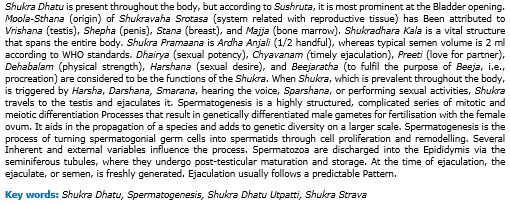Review on Utpatti of Shukra Dhatu as per Ayurveda
Keywords:
Shukra Dhatu, Spermatogenesis, Shukra Dhatu Utpatti, Shukra StravaAbstract
Shukra Dhatu is present throughout the body, but according to Sushruta, it is most prominent at the Bladder opening. Moola-Sthana (origin) of Shukravaha Srotasa (system related with reproductive tissue) has Been attributed to Vrishana (testis), Shepha (penis), Stana (breast), and Majja (bone marrow). Shukradhara Kala is a vital structure that spans the entire body. Shukra Pramaana is Ardha Anjali (1/2 handful), whereas typical semen volume is 2 ml according to WHO standards. Dhairya (sexual potency), Chyavanam (timely ejaculation), Preeti (love for partner), Dehabalam (physical strength), Harshana (sexual desire), and Beejaratha (to fulfil the purpose of Beeja, i.e., procreation) are considered to be the functions of the Shukra. When Shukra, which is prevalent throughout the body, is triggered by Harsha, Darshana, Smarana, hearing the voice, Sparshana, or performing sexual activities, Shukra travels to the testis and ejaculates it. Spermatogenesis is a highly structured, complicated series of mitotic and meiotic differentiation Processes that result in genetically differentiated male gametes for fertilisation with the female ovum. It aids in the propagation of a species and adds to genetic diversity on a larger scale. Spermatogenesis is the process of turning spermatogonial germ cells into spermatids through cell proliferation and remodelling. Several Inherent and external variables influence the process. Spermatozoa are discharged into the Epididymis via the seminiferous tubules, where they undergo post-testicular maturation and storage. At the time of ejaculation, the ejaculate, or semen, is freshly generated. Ejaculation usually follows a predictable Pattern.
Downloads
References
Agnivesha. Charaka Samhita, Agnivesha’s treatise refined and annotated by Charaka and redacted by Drudabala, with Ayurveda deepika commentary by chakrapani Varanasi, Chaukamba Sanskrit Sansthan; reprint, 2004.
Astanga Sangraha with Hindi Vyakhya by Lal Chandra Shastry Vaidya, Baidyanatha Publications, -1989.
Astanga Hridaya with the commentaries, Sarvangasundara ofArundatta and Ayurveda rasayana of Hemadri, edited by Pandit Hari Sadasiva Sastri Paradakara Bhisagacarya; Chaukhamba Orientalia, Varanasi, Ninth Edition, 2002.
Samhita, Sutrasthana, with English Translation by Krishnamurthy K.H., Varanasi; Chaukhambha Vishwabharati. Reprint 2006.
Chakrapanidatta. Chakradatta with vaidhya prabha Hindi commentary by Dr indradev Tripathi, edited By Prof Ramanath Dwividy, 1st edition Varanasi, Chaukhamba Sanskrit Sansthan, 1992.
Sharangadhara Samhita with Adhamalla’s Deepika and Kashiram’s Gudartha Deepika commentary, Varanasi, Krishnadas Academy, reprint, 2000.
Sushruta Samhita, the Nibandha Sangraha commentary by Dalhanacharya and the Nyayachandrika Panjika of Sri. Gayadasacharya on Nidana Sthana, edited by Vaidya Yadavji Trikamji Acharya and Narayanarama Acharya, Kavyatirtha, Varanasi: Chaukhambha Surabharati; reprint, 2003.
The Kashyapa Samhita or Vriddha Jivaka tantra by vriddha Jivaka revised by Vatsya translation and Commentary by Prof.P.V.Tewari, Varanasi, Choukambha visvabharati, 1996.
Vagbhata or Vriddha Vagbhata. Ashtanga Sangraha with the Shashilekha Sanskrit commentary by Indu, 1st ed. Varanasi: Chaukhambha Sanskrit Series Office, 2009
Vagbhata, Ashtanga Hridaya with commentaries of Sarvanga Sundari of Arundatta and Ayurveda Rasayana of Hemadri; Krishnadas Academy, Varanasi- Reprint, 1982.
Vangasen Samhita with hindi commentary from Dr. Rajiv Kumara Roy, edited by Dr. Rajiv KumaraRoy, 1st ed. Varanasi: Prachya Prakashan, 2000.
Yogaratnakar. With Vaidhya Prabha Hindi commentary, by Dr. Indradev Tripathi and Dr. Dayashankar Tripathi, Varanasi, Krishna Das Academy, 1st edition 1998.














